Multiple Choice
Identify the
choice that best completes the statement or answers the question.
|
|
|
1.
|
What are the steps of the Scientific Method? Select the one that is listed in the correct order:
a. | ask questions, establish an
experiment, collect data, form
an hypothesis, draw
a
conclusion. make
a prediction, and make an
observation | b. | make an observation. ask questions, form an hypothesis, establish an experiment. collect
data, draw a
conclusion, make
a
prediction | c. | make a prediction, draw a
conclusion, collect data,
establish an experiment. form an
hypothesis, ask Questions, and make an
observation | d. | establish an experiment, collect
data, make an observation, ask
questions, draw a
conclusion, form a
hypothesis, and make a prediction |
|
|
|
2.
|
Which organelle is directly involved in cellular transport?
a. | endoplasmic reticulum
(ER) | b. | mitochondria | c. | Golgi apparatus | d. | cell membrane |
|
|
|
3.
|
Which plant organelle is the site of photosynthesis?
a. | chloroplast | b. | centriole | c. | cell wall | d. | mitochondria |
|
|
|
4.
|
a. | individual
1 | b. | individual
2 | c. | individual
3 | d. | individual
5 |
|
|
|
5.
|
The ancestors of po
lar bears became separated from brown bears when they moved from the
mainland
to the Arctic ice. Since they were in different environments, the traits selected in the
Arctic ice population were different than the traits selected in the
land population. Eventu;illy,
the two populations could no longer interbreed. Today.
we call the descend;ints of
the Arctic
ice po pulat1on polar bears and the descendants of the mainl;ind
popul;ition brown bears. This
phenomenon of one group of organisms
separating and forming two
reproductively
isolated
groups 1s known as
a. | extinction | b. | parasitism | c. | speciation | d. | convergent evolution |
|
|
|
6.
|
a. | order
W | b. | order
X | c. | order
Y | d. | order
Z |
|
|
|
7.
|
An abandoned home site from the 1950s is
discovered on a rural
road in the southeastern United
States. The entire front of the building is covered with a type of clinging vine. The
uncontrolled
growth of this
plant has resulted in the destruction of the front of the
home. This plant does not
seem
bothered by any natural predators. It was later discovered the scientific name for this plant
is
Lonicera japonica. Based on
these facts. which of the
fo llowing is a reasonable inference?
a. | All clinging vines will destroy property | b. | The home
was made of cheap
materials | c. | With human guidance.
the vine would be
beautiful. | d. | The vine is an invasive plant brought from Japan. |
|
|
|
8.
|
What is Qualitative
data?
a. | observations made with your
senses | b. | information that cannot be assigned a
numerical value | c. | examples of qualitative data indude:
shades of color, texture, taste, or smell | d. | all of the
above |
|
|
|
9.
|
What is Quantitative
data?
a. | measurements and anything
that can be expressed as a number | b. | the subjective part of collecting
data | c. | data centered on describing
qualities | d. | data that cannot be expressed asa number |
|
|
|
10.
|
Which term below best describes the paramecium shown below?
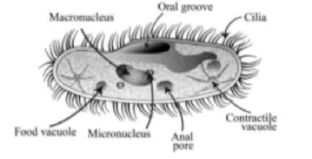
a. | unicellular | b. | multi-cellulur | c. | non-cellular | d. | bi-cellular |
|
|
|
11.
|
A DNA double
helix has two complementary
strands. The sequence below is the base sequence
of one strand. During replication. this strand experiences an inversion mutation. Identify the
correct results.
TTAAGCCCAGCTTAA
a. | TTA AGC ACC CCT TAA | b. | TTA ACC CCA
CCT
TAA | c. | UUA UCC CCA CCU
UAA | d. | TTAACCCCCCT AA |
|
|
|
12.
|
Which of the following characteristics is common to both bacteria and viruses?
a. | contain genetic
material | b. | can be killed using
antibiotics | c. | have a cell membrane | d. | have a
protein coat |
|
|
|
13.
|
Which of the following statements is
NOT true?
a. | In plants, the products of photosynthesis are used as reactants in respiration, and the
products of respiration are used to fuel photosynthesis. | b. | Plants carrying
out photosynthesis provide a
source of oxygen for animals.
and respiration
provides a
source of carbon dioxide
for plants. | c. | Photosynthesis and respiration convert energy from one
form to another. | d. | Plant
and animal cells perform
both respiration and
photosynthesis. |
|
|
|
14.
|
What is the process
of converting carbon dioxide. water. and light energy into oxygen and high
energy sugar molecules?
a. | biosynthesis | b. | chloroplast | c. | glycolsis | d. | photosynthesis. |
|
|
|
15.
|
The chemical energy supply for all living cells is contained
in a particular molecule.
When
this molecule breaks down, it releases energy that may be used for activities such as
muscle
contractions.
photosynthesis. and locomotion. What is the molecule that is the storehouse
of
cellular energy?
|
|
|
16.
|
Observed evidence for evolution includes
a. | fossils. DNA sequences, and homologous structures. | b. | tropisms, genetic drift. and speciation. | c. | gene flow, mutations, and tropisms. | d. | phenotypes. food preferences. and fossils. |
|
|
|
17.
|
Charles Darwin's
ideas form the basis of the modern theory of evolution. Although he was
not the
first to propose that organisms changed over
time, he was the first to propose a valid
mechanism by which this happened.
Central to his theory was the importance given to natural
variation and its place in
the context of natural selection.
Which of the following statements
MOST accurately describes Darwin's proposal on the
nature of inherited variations?
a. | Variations are ONLY inherited if they have proven to
have a positive adaptive value in
the
previous generation. | b. | Variations that
have a negative adaptive va
lue are LESS likely
to be passed from parent
to offspring. | c. | Inherited variations occur by chance, and have a variable degree of adaptive value to the
individual organism during its lifetime. | d. | Inherited variations occur
because of environmental
conditions. and have a
variable
degree of adaptive
value to the individual organism during its lifetime. |
|
|
|
18.
|
Many types of interactions exist between species. Which of the diagrams below represents
commensalism?
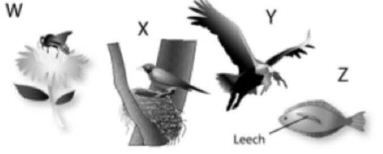
a. | Diagram
W | b. | Diagram
X | c. | Diagram
Y | d. | Diagram
Z |
|
|
|
19.
|
Which two groups of organisms listed below are responsible for recycling decomposing
organic
matter within the ecosystem?
a. | plants and
animals | b. | animals and
invertebrates | c. | bacteria and fungi | d. | animals and
fungi |
|
|
|
20.
|
Which
of the following statements
correctly
represents a negative
impact of fossil fuel usage?
a. | The burning of fossi l fuels disrupts the watercyde by adding hydrogen to
the
atmosphere. | b. | Drilling for fossil fuels disrupts the carbon cycle by
adding
hydrogen to the atmosphere | c. | The burning of fossi l fuels releases carbon and
carbon-based greenhouse gases
to the
atmosphere in excess
volume. | d. | Mining for fossil fue ls has
irreversibly changed the
ecologic<1I biomes of
the Earth. |
|
|
|
21.
|
Which of the following statements accurately describes the difference between the way bacteria
cause
disease and the way that viruses cause disease?
a. | Both bacteria and viruses use host cells to reproduce, but viruses kill the host cell
immediately, while bacteria maintain life within the host cell indefinitely. | b. | Bacteria only cause disease by entering the body through the bloodstream and
infecting
a host cell, and viruses only cause disease by entering the body through air
passages and
infecting a host cell. | c. | Bacteria cause disease by incorporating their DNA into the host's DNA, and viruses cause
disease by incorporating
their RNA in the host's RNA. | d. | Bacteria are
living cells that grow and
reproduce in the body and produce toxins or
damage tissues they grow in. Viruses use host cells to reproduce, and these host cells
usually die when
newly produced virus particles
are released. |
|
|
|
22.
|
The movement of water
across a selectively permeable
membrane is
a. | active transport | b. | osmosis. | c. | mitosis | d. | meiosis. |
|
|
|
23.
|
A new type of organism
is found living in an extremely cold environment This organism is
unicellular and has a cell wall that lacks peptidoglycan (protein-carbohydrate
molecule). To
which kingdom does this organism belong?
a. | Archaebacteria | b. | Eubacteria | c. | Protista | d. | fungi |
|
|
|
24.
|
During meiosis. crossing
over may occur with pairs
of homologous chromosomes. What is the
result of crossing over?
a. | genetic variation | b. | genetic mutations | c. | fertilization | d. | evolution |
|
|
|
25.
|
If a body cell of a
human contains 46 chromosomes,
how many chromosomes would a
human
egg cell contain?
|
|
|
26.
|
If a body cell of a
human contains 46 chromosomes,
how many chromosomes would a
human
egg cell contain?
|
|
|
27.
|
Most typically, the order in which the steps of scientific
investigations(Scientific Method) are applied is
a. | controlled experiment, hypothesis, analysis of results, observations, questions,
conclusions. | b. | observations, controlled experiment, hypothesis, analysis of results, conclusions,
questions. | c. | observations, questions, hypothesis, controlled experiment, analysis of results,
conclusions. | d. | questions, observations, analysis of results, controlled experiment, conclusions,
hypothesis. |
|
|
|
28.
|
Which
of the following phrases contains quantitative data?
a. | green leaves surround
white
flowers | b. | Ricky's football jersey is number 85 | c. | seeds sprout more quickly when it
is warm | d. | water evaporates ata rate of2 ml per
minute |
|
|
|
29.
|
What does the
carrying capacity represent?
a. | the amount of mass in the entire population | b. | the life expectancy of each organism | c. | the largest number of individuals a given environment can
support | d. | the number of resources needed by each population in an
ecosystem |
|
|
|
30.
|
Which cycle of matter
does the illustration
shown below BEST represent?
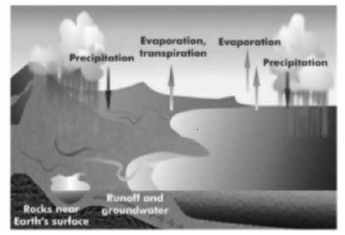
a. | the water
cyde | b. | the carbon cyde | c. | the nitrogen cycle | d. | the phosphorus cycle |
|
|
|
31.
|
Which statement BEST describes the relationship between an urchin and the other members of
the
food web?
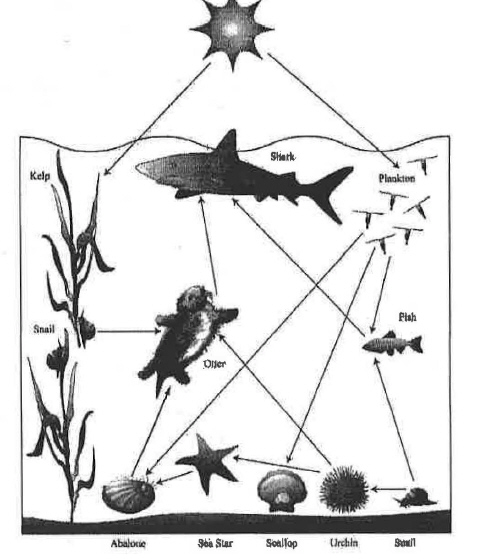
a. | the urchin is prey to the
snail and to the otter. | b. | the urchin is a competitor to the sea star and the
otter. | c. | the urchin is a predator to the snail and a competitor to the
fish. | d. | the urchin is a predator to the sea star and the
snail |
|
|
|
32.
|
What is the process
that is responsible for the variations that exist within a species or a change in the allele
frequency?
a. | macroevolution | b. | speciation | c. | microevolution | d. | genetic Drift |
|
|
|
33.
|
Identify the physical
feature below that caused sea turtles to adapt to life in the ocean.
a. | large protective
shell | b. | flipper-like legs | c. | amniotic egg | d. | short tail |
|
|
|
34.
|
Researchers collected
information on pond size preference for several different frog species
found in South Carolina.
Each frog species has a unique preference for a particular pond size.
Within each pond, the number
of frogs of each species was counted and a dominant frog species was determined. The
graph below shows how pond size related to percentages of one native species, the burrowing
mudhen.
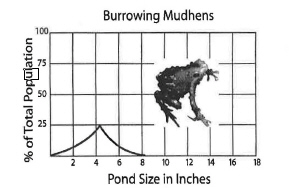 At pond sizes above 6 meters, there are
not enough burrowing mudhens to maintain genetic At pond sizes above 6 meters, there are
not enough burrowing mudhens to maintain genetic
diversity and their numbers begin to fall. What
biological force is acting upon the burrowing
mudhen population?
a. | natural
selection | b. | selective breeding | c. | extinction | d. | emigration |
|
|
|
35.
|
The appearance of fins and
streamlined bodies on diverse groups of animals such as dolphins,sharks, and penguins is an example
of
a. | co-evolution. | b. | adaptive radiation. | c. | convergent evolution. | d. | macroevolution. |
|
|
|
36.
|
In rabbits, the fur color and
ear position are two genetic traits. Each trait is located on a separate chromosome. The allele for
producing brown fur (B) is dominant to the allele for producing white fur (b). The allele for
producing straight ears (E) is
dominant to the allele for producing floppy ears (e). What are the possible genotypes for a rabbit
with brown fur and floppy ears?
a. | Bbee and
BBee | b. | Bbee, BbEe, BBee, and BBEe | c. | BBee and BBEE | d. | BbEe, BBEe, BbEE, and
BBE |
|
|
|
37.
|
In some fruit flies the allele
for having long bristles (B) is dominant to the allele for having short bristles (b). A scientist
mated a batch of fruit flies with genotypes as shown in the Punnett square below. What is the
probability that the offspring will be born with short bristles?
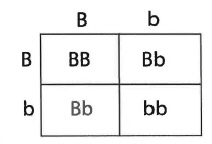
|
|
|
38.
|
In mice, brown hair is
dominant to white. Cross a heterozygous female with a heterozygous male.The genotypic ratio will
yield
a. | 3brown:1
white. | b. | 3white:1 brown. | c. | 1brown:2tan:1 white. | d. | 100% brown
hair |
|
|
|
39.
|
A landscaper crossed
two heterozygous junipers. She noticed that of the offspring junipers, 73%
were short and 27%were tall. These results indicate that the allele for shortness
is
a. | dominant. | b. | recessive | c. | co-dominant | d. | incompletely dominant. |
|
|
|
40.
|
An amateur
horticulturist crossed a pink orchid flower with a purple orchid flower. The resulting offspring
flowers were pink with purple stripes. How would you characterize the allele for color in
this orchid flower?
a. | dominant. | b. | recessive | c. | co-dominant | d. | polygenetic |
|
|
|
41.
|
To learn how species
are related, scientists can compare structures found in the species to find similarities. The skulls
shown below are from four different animals.
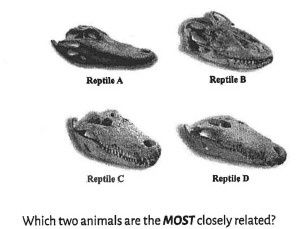
a. | Reptiles A &
B | b. | Reptiles C &
B | c. | Reptiles A &
D | d. | Reptiles C &
D |
|
|
|
42.
|
Bacteria are being used
to breakdown pollutants into harmless molecules and to produce
medicines. Bacteria are also
cultured so that their enzymes can be extracted to make soy sauce,cheese, chewing gum and laundry
detergent. Which of the following characteristics of bacteria makes them valuable in pollution
cleanup, the making of medicine and industry?
a. | Bacterial populations
multiply quickly, increasing the potential for pollution cleanup,
medicine making, and the
manufacture of industrial products. | b. | All bacteria have exactly the same genetic code, so any type of bacteria can potentially be used for pollution cleanup, medicine making and the manufacture of industrial products. | c. | Bacteria are not susceptible to threats, such as viruses, so bacterial
populations will never suffer any adverse effects. | d. | The chemical reactions that take place within
bacterial cells do not have any byproducts and, therefore, do not interfere with their roles as
pollution cleaners or medicine makers |
|
|
|
43.
|
Proteins are made in
the ribosomes of a cell, whereas DNA is found only in
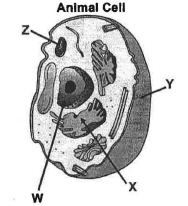
a. | organelle
W | b. | organelle
Y | c. | organelle
X | d. | organelle
Z |
|
|
|
44.
|
a. | images
X&Z | b. | only image
Z | c. | images
W&Y | d. | only image
Y |
|
|
|
45.
|
This molecule carries information from the DNA in the nucleus out into the
cytoplasm of the cell.
|
|
|
46.
|
a. | transcription | b. | translation | c. | replication | d. | cytokinesis |
|
|
|
47.
|
a. | anaphase | b. | telophase | c. | cytokinesis | d. | interphase |
|
|
|
48.
|
A cell contains a
nucleus, mitochondria, and endoplasmic reticulum. Given only this knowledge, what can you conclude
about the identity of the cell?
a. | It is a plant
cell. | b. | It is an animal cell. | c. | It is a eukaryotic
cell. | d. | It is a prokaryotic cell |
|
|
|
49.
|
A child is diagnosed
with a rare genetic disease. Neither parent has the disease. How might the child have inherited the
disorder?
a. | The disorder is dominant and
was carried by one parent. | b. | The disorder is recessive and carried by both
parents. | c. | The disorder is sex-linked and carried by the
father. | d. | The disorder could only be caused by a mutation during mitosis because neither
parent had the disorder. |
|
|
|
50.
|
Crossing over occurs
regularly during meiosis. Why is crossing over advantageous to species?
a. | It destroys damaging
genes. | b. | It ensures that equal numbers of males and females are born into a
population. | c. | It increases genetic variation. | d. | It decreases the possibility of
mutations. |
|
|
|
51.
|
DNA is a large molecule
composed of two strands of nucleotides. Each nucleotide contains a 5-carbon sugar, a phosphate group and one
nitrogen base. There are only four nitrogen bases associated with DNA: cytosine, guanine, thymine,
and adenine. These nucleotides encode hereditary information, and these segments of information are
commonly called genes. If all 30,000 genes are made up of the same twenty nucleotides, how does one
gene differ from another?
a. | the size of the nitrogen
bases | b. | the type of bonds between the nucleotides | c. | the sequence of the nitrogen
bases | d. | the phenotypes of the nitrogen
bases |
|
|
|
52.
|
a. | J
only | b. | both J and K | c. | K only | d. | neither J or K |
|
|
|
53.
|
Quinn and Roseanna
collected various samples of the flora from their backyard and carefully examined them in the school
laboratory using proper equipment. Of the three samples shown below, which plant(s) can be classified
as nonvascular?
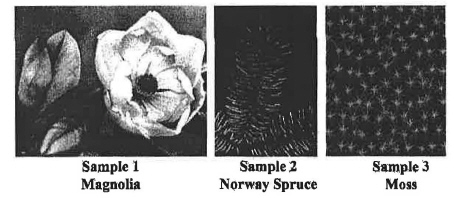
a. | sample
1 | b. | sample
2 | c. | sample 1 &
2 | d. | sample
3 |
|
|
|
54.
|
Consider the two plants
shown. Based on their root structures, which plant is better adapted to life in a desert
environment?
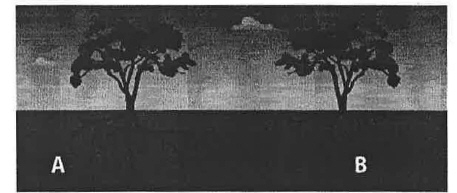
a. | Plant A is better adapted to
life in a desert environment because its long thick roots reach deep into the earth to absorb water
from the water table. | b. | Plant Bis better adapted to life in a desert environment because its short
shallow roots absorb water near the surface after rains. | c. | Root structure is NOT a factor in determining the
degree ofadaptation. Leaf structure
is the only determining factor as to whether or not a plant is
adapted to a desert
environment. | d. | Neither plant A nor plant Bare adapted to a desert environment because desert
plants don't have roots. |
|
|
|
55.
|
a. |  | b. |  | c. |  | d. | stored chemically in the ribose sugar
molecule. |
|
|
|
56.
|
a. | ATP is responsible for
makin~energy within the
cell. | b. | ATP is the molecule used for energy storage within the
cell. | c. | ADP is the molecule used for energy storage within the
cell. | d. | ADP is responsible for making and regulating energy within the
cell. |
|
|
|
57.
|
An electronics store is
burglarized at twilight. A
witness across the street sees
the burglar force his way in by breaking a window. After the police arrive. they find blood on the broken glass and
send it to the laboratory for ONA analysis. Down at the precinct. the witness looks over a lineup of
suspects, but admits that all
three of the suspects look very much like the man he saw breaking into the store. A DNA analysis of the three suspects
produces the fingerprints shown here. Which suspect was MOST LIKELY the
burglar?
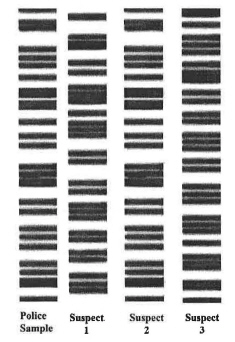
a. | Suspect
1 | b. | Suspect
2 | c. | Suspect
3 | d. | All suspects have some of
the DNA markers from the police sample. so the test
is
inconclusive |
|
|
|
58.
|
Use the following
passage to answer question 58.
The peppered moth is often used as a case
study to illustrate natural selection. The peppered moth is found in two speckled colorations: light-colored and dark
colored. The allele for darkcolored moths is dominant, while the allele for light colored moths is
recessive. In 1850s England, most of the peppered moth population was light in color and blended in with the birch trees they commonly landed on. Their light coloration, or camouflage, makes it hard for birds and other predators to
spot and capture them. Dark-colored peppered moths were also present but were fewer in number because
they were more susceptible to predation. By the early1900s, industrial air pollution had covered the
birch trees with soot, generally darkening the appearance of the
bark. The dark-colored moths now blended in with the trees more effectively th an the
lightcolored moths, and as a result were less easily spotted by predators. Correspondingly, the dark colored moths became
greater in number than the
light-colored moths.
----Which of the following statements accurately represents the evolutionary
trend demonstrated by the peppered moths?
a. | A smaller percentage of
light-colored moths survive to reproduce, shrinking the gene pool and causing
mutations. | b. | More and more dark-colored moths survive to reproduce, which shifted the
allele
frequency towards the dark-colored allele. | c. | Over time, the light-colored moths will become
homozygous for the light allele and
become extinct. | d. | Overtime, the birds will get used to eatingthe
light-colored moths and stop eatingthe
dark-colored
moths |
|
|
|
59.
|
In the United States,
plastic products are considered to be disposable. In other words, as soon as a plastic container is
emptied, a diaper is soiled, or a toy is broken, it goes to a landfill. Plastics are composed oflong
chains of molecules linked tightly together. Saprophytes cannot penetrate these molecules easily.
Therefore, some plastics take nearly 200 years to completely break down. Also plastics are manufactured from oil, coal
and natural gas, all of which are nonrenewable resources. What is a reasonable solution to the
plastic problem that takes into account ecological, social and economic
factors?
a. | Immediately stop the
manufacture of all plastic products. | b. | Pull all of the plastic out of existing landfills, recycle it, and make no more
plastic from raw materials. | c. | Develop plastics using renewable resources, such as plant products, that
decomposers can penetrate and break down. | d. | Encourage consumers to stop purchasing any
products made from or packaged in plastic until all plastic manufacturers are forced out of
business. |
|
|
|
60.
|
What are observable
facts and events occurring in nature that are experienced through our
senses is
called?
a. | asking
questions | b. | hypothesis | c. | control group | d. | natural phenomenon |
|
|
|
61.
|
Read the paragraph and then match each item with the correct statement
below.
An experiment was designed to investigate the effect of
caffeine on the heartbeat of water fleas. Two populations of water fleas were cultured. Both
populations had water with the same mineral content, were supplied with identical amounts of bacteria
as food, received the same amount of light, and had their temperature maintained at 20ºC. Every
two hours, water fleas from both populations were selected and their heartbeats were monitored. The
fleas of population one had caffeine administered five minutes before their heartbeat was checked.
The fleas of population two were given nothing.
What part of the experiment was the
food?
a. | independent
variable | b. | dependent variable | c. | constant | d. | control group |
|
|
|
62.
|
Read the paragraph and then match each item with the correct statement
below.
An experiment was designed to investigate the effect of
caffeine on the heartbeat of water fleas. Two populations of water fleas were cultured. Both
populations had water with the same mineral content, were supplied with identical amounts of bacteria
as food, received the same amount of light, and had their temperature maintained at 20ºC. Every
two hours, water fleas from both populations were selected and their heartbeats were monitored. The
fleas of population one had caffeine administered five minutes before their heartbeat was checked.
The fleas of population two were given nothing.
What part of the experiment was the
heartbeat?
a. | independent
variable | b. | dependent variable | c. | constant | d. | control group |
|
|
|
63.
|
Read the paragraph and then match each item with the correct statement
below.
An experiment was designed to investigate the effect of
caffeine on the heartbeat of water fleas. Two populations of water fleas were cultured. Both
populations had water with the same mineral content, were supplied with identical amounts of bacteria
as food, received the same amount of light, and had their temperature maintained at 20ºC. Every
two hours, water fleas from both populations were selected and their heartbeats were monitored. The
fleas of population one had caffeine administered five minutes before their heartbeat was checked.
The fleas of population two were given nothing.
What part of the experiment was the water
temperature?
a. | independent
variable | b. | dependent variable | c. | constant | d. | control group |
|
|
|
64.
|
Read the paragraph and then match each item with the correct statement
below.
An experiment was designed to investigate the effect of
caffeine on the heartbeat of water fleas. Two populations of water fleas were cultured. Both
populations had water with the same mineral content, were supplied with identical amounts of bacteria
as food, received the same amount of light, and had their temperature maintained at 20ºC. Every
two hours, water fleas from both populations were selected and their heartbeats were monitored. The
fleas of population one had caffeine administered five minutes before their heartbeat was checked.
The fleas of population two were given nothing.
What part of the experiment was the population
two?
a. | independent
variable | b. | dependent variable | c. | constant | d. | control group |
|
|
|
65.
|
Read the paragraph and then match each item with the correct statement
below.
An experiment was designed to investigate the effect of
caffeine on the heartbeat of water fleas. Two populations of water fleas were cultured. Both
populations had water with the same mineral content, were supplied with identical amounts of bacteria
as food, received the same amount of light, and had their temperature maintained at 20ºC. Every
two hours, water fleas from both populations were selected and their heartbeats were monitored. The
fleas of population one had caffeine administered five minutes before their heartbeat was checked.
The fleas of population two were given nothing.
What part of the experiment was the
caffeine?
a. | independent
variable | b. | dependent variable | c. | constant | d. | control group |
|